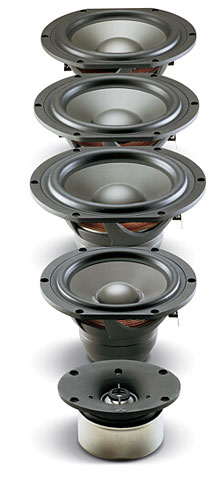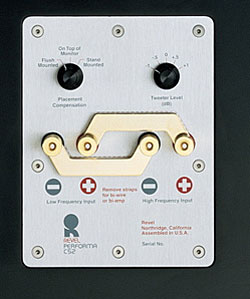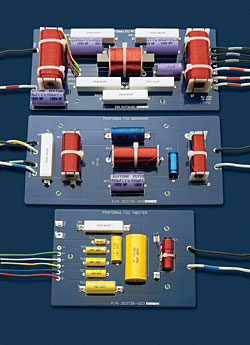Revel Performa F52 Speaker System Page 2
The subwoofer I used was the Performa B15, a slightly older version of the current B15a. According to Revel, both are essentially identical apart from some minor cosmetic differences. For more on the B15, click over to our reviews of the Performa F30 system and Performa F32 system. You can also see more on the B15 here. The M22 surrounds are described in the Performa F32 system review.
 Setup
Setup
In my system, as in most home theater setups, the position of the speakers is constrained by the location of the screen. The front speaker and main seating positions for my room were determined several years ago before I installed the screen. The single constraint was to allow enough room between the left and right speakers for the intended screen size.
I arranged the Revel F52 system as I have most surround sound speaker packages since then. The F52s were located to the left and right of the screen and just slightly forward of it. Neither speaker was closer than three feet from the nearest wall in any direction. The F52s were toed-in so that their axes crossed at the center seating position, firing down the long dimension of my 15.5' x 26' x 8' home theater room. The C52 was positioned just in front of and below the screen on a low stand, and aimed slightly upwards.
The surrounds were at the left and right in the rear of the room, about five feet above the floor. The B15 subwoofer was located in the right front corner of the room, with its parametric equalization set to provide the most uniform low frequency response at the main seating area.
Performa-nce: Music
I'll begin, as I usually do, with the performance of the left and right F52s operating in two-channel without the aid of the B15 subwoofer. If a speaker can't do a good job reproducing music, it has no place in a serious audio system—home theater or otherwise.
The F52 performs superbly on music. On well-recorded material everything was precisely rendered without going over-the-top. In the past, Revels have leaned a bit toward the analytical—or, as Steven Stone put it in his review of the F32s, "matter-of-fact." There is some of that in the F52s, and there should be. Speakers should reproduce what's fed into them, no more and no less. But having said that, I believe these are the sweetest-sounding Revels I've ever heard.
Not that they tip over into the warm and fuzzy category—far from it. But there's just enough fullness to their sound in my listening room to let them appeal to both the solid-state and tube factions of the audio divide. The F52s combine detail with sweetness in a way that I've never heard in quite the same way from earlier Revel designs.
On vocals they appear to be completely free of the colorations that afflict lesser speakers. Voices sound right, with no boxiness, nasality, or sibilant sizzle. One of the first recordings I consistently turn to for male vocals is Gordon Lightfoot's If You Could Read My Mind (Reprise). Although decades old, the best cuts off this recording still stand up as a reference for natural-sounding, studio-produced male vocals. (Lightfoot's later recordings for Reprise became progressively more processed-sounding.) On the F52s Gordon's voice had just the right weighting, warm but not unnaturally rich. The top end had a natural airiness but without any fizz or exaggerated sibilants. The midrange was supremely natural. The guitar accompaniment was simply there.
 The same qualities were evident on other well-recorded vocals as well, from female solos to massed chorus. Jennifer Warnes' voice sparkled on the onetime audiophile fave Famous Blue Raincoat, but was always recognizably real.
The same qualities were evident on other well-recorded vocals as well, from female solos to massed chorus. Jennifer Warnes' voice sparkled on the onetime audiophile fave Famous Blue Raincoat, but was always recognizably real.
The hits continued into the deep bass. While the F52 won't catch the deepest notes of a pipe organ, it handles the bottom end of virtually all other instruments with power and clarity.
I'm fortunate in that most good speakers can produce a strong central image in my listening room, and the Revels were no exception. They produced a well-defined soundstage across the board, in both width and depth.
Despite what I have just said about the F52's pleasant warmth, it can, in my system and room, sometimes subtly obscure detail higher up in the frequency spectrum when the music gets loud and complex. A more powerful amplifier than the Proceed AMP5 (125Wpc into 8 ohms) can help. The Parasound Halo A51 (250Wpc into 8 ohms) did marginally tighten and brighten the sound, which was generally a plus. The Contour control on the F52 can also help with this, depending on the characteristics of you room. In my situation it leaned out the sound a little too much. From the above description, it might sound like the bass response of the F52 is such that adding a subwoofer would not provide much of an improvement, at least on music. That may be true if you choose a subwoofer that's not up to the task, or one that won't blend well with the F52s. But when I brought in the Revel Performa B15 and crossed it over at 80Hz, the improvement was dramatic. (I also rolled the F52s off below that frequency, in both cases using the high- and low-pass filters in the Anthem D1 pre-pro.) Deep bass came through with more relaxed depth and power. Organ pedals energized the room. Drums had a more gutsy impact. And the whole sonic fabric opened up while maintaining the system's overall musical honesty.
There are two reasons for this improvement. First, rolling off the F52 below 80Hz takes some of the load off the speaker and amplifier. And second, the required position of the F52s in my room, while first rate for imaging, is not absolutely ideal through the mid and upper bass. Routing the frequencies below 80Hz to a well-positioned and equalized B15 provided a significant upgrade to the system's overall sound. And yes, the F52s and B15 blend beautifully in my room.
Performa-nce: Movies
Music may hath charms that make it better for determining the pure audio quality of speakers, but movie soundtracks often make more crushing demands on a system's ability to handle a wide dynamic range, from the quietest whisper to the most explosive effects. Whether I was watching Casanova, with its delightful Baroque classical soundtrack, or the intense underwater action in the newly remastered Crimson Tide, the F52 system never let me down. It was as comfortable on the quietest, most subtle soundtrack as on the big, noisy blockbusters that are the staple of home theater demos everywhere.
The sound of the Revels on some of the new HD DVDs (as auditioned from the SPDIF digital output of the Toshiba HD DVD player) was particularly impressive. So far, most of the HD DVDs released not only provide a pristine image but also noticeable sonic improvements over what we have come to expect from garden-variety Dolby Digital and DTS on ordinary standard definition DVDs.
 One of the best is Serenity. The quiet moments are beautifully rendered on the F52 system. Check out the scenes in the movie's final act that begin with the memorial service in chapter 19 for some of the sweetest-sounding strings I've ever heard from film sound. And the system didn't hiccup when asked to reproduce the immense dynamic range in chapter 3. Here Serenity first glides into view, accompanied by a few notes of rich, sweet, softly played strings. Then everything breaks loose as the ship begins its erratic landing approach and the music swells to near-distortion levels (which appears to be slight overloading in the soundtrack). Again, the F52 grabs onto this abrupt shift in tone and slides through it without ever turning mushy or unpleasant.
One of the best is Serenity. The quiet moments are beautifully rendered on the F52 system. Check out the scenes in the movie's final act that begin with the memorial service in chapter 19 for some of the sweetest-sounding strings I've ever heard from film sound. And the system didn't hiccup when asked to reproduce the immense dynamic range in chapter 3. Here Serenity first glides into view, accompanied by a few notes of rich, sweet, softly played strings. Then everything breaks loose as the ship begins its erratic landing approach and the music swells to near-distortion levels (which appears to be slight overloading in the soundtrack). Again, the F52 grabs onto this abrupt shift in tone and slides through it without ever turning mushy or unpleasant.
The Phantom of the Opera is, of course, a very different movie. While flawed, several scenes stand out as sonic showpieces, particularly Christine's aria early in the film (a new and not so blue diva scene!) and the masquerade ball. The voices, both solo and chorus, are clean and natural sounding, and the instrumental accompaniment expansive and cinematic without a trace of excess edge or brightness. The full orchestra is just a little thinner in the mid bass than I'd like, but comparisons to a wide variety of other DVDs indicate that this is clearly in the recording and does not originate in the Revel speakers.
The F52 system produced a huge bubble of sound that consistently transported me into one film after another. The bottom line is that it melted away into the overall experience in a way that kept me engrossed in the film, not the sound of the speakers.
I can't wrap this up discussion without bringing up my favorite HD DVD to date. The soundtrack on Apollo 13 is astonishing. I've seen it criticized elsewhere as dated and distorted. Not on the Revel F52s, it isn't! The famous launch sequence, a classic demo clip if ever there was one, is a stunner from the gloriously raucous sound of the launch itself to the magnificent Shawn Murphy recording of one of James Horner's best scores. It's a treat on the Revels from beginning to end. That launch scene is the last thing I play when demoing HD DVD to visitors, because following it up with anything else would be anticlimactic. Here's a hint: Don't start with the launch chapter itself, but rather the middle of the chapter before, as the astronauts suit up. And continue to the spot where the ground observers start to clear the reviewing stands. And by the way, the Safari Inn motel in this sequence is actually located in Burbank, California!
Conclusion
Revel shares some of the most advanced engineering facilities in the known speaker universe with other brands under the big Harman International tent. While the Ultima Series may be Revel's flagship line, it is, as noted earlier, currently undergoing a complete redesign. For now, the Performa F52 may well be the best speaker in the Revel lineup. And the total package—the F52s, the C52, the M22s and the B15a—works together to provide great listening from either music or movies. While no speaker will ever please everyone, if you're shopping in this price range you owe it to yourself to hear this system.
Highs and Lows
Highs
Spectacular sound on movies and music
Expensive, but nevertheless a solid value in today's speaker market
Subtle but useful woofer contour and tweeter level adjustments
Three-band parametric equalization on B15a subwoofer
Lows
Keep the narrow, heavy, slightly unstable F52 clear of large pets and small children
A bit too much mid bass warmth from the F52 when driven full range
- Log in or register to post comments




































































